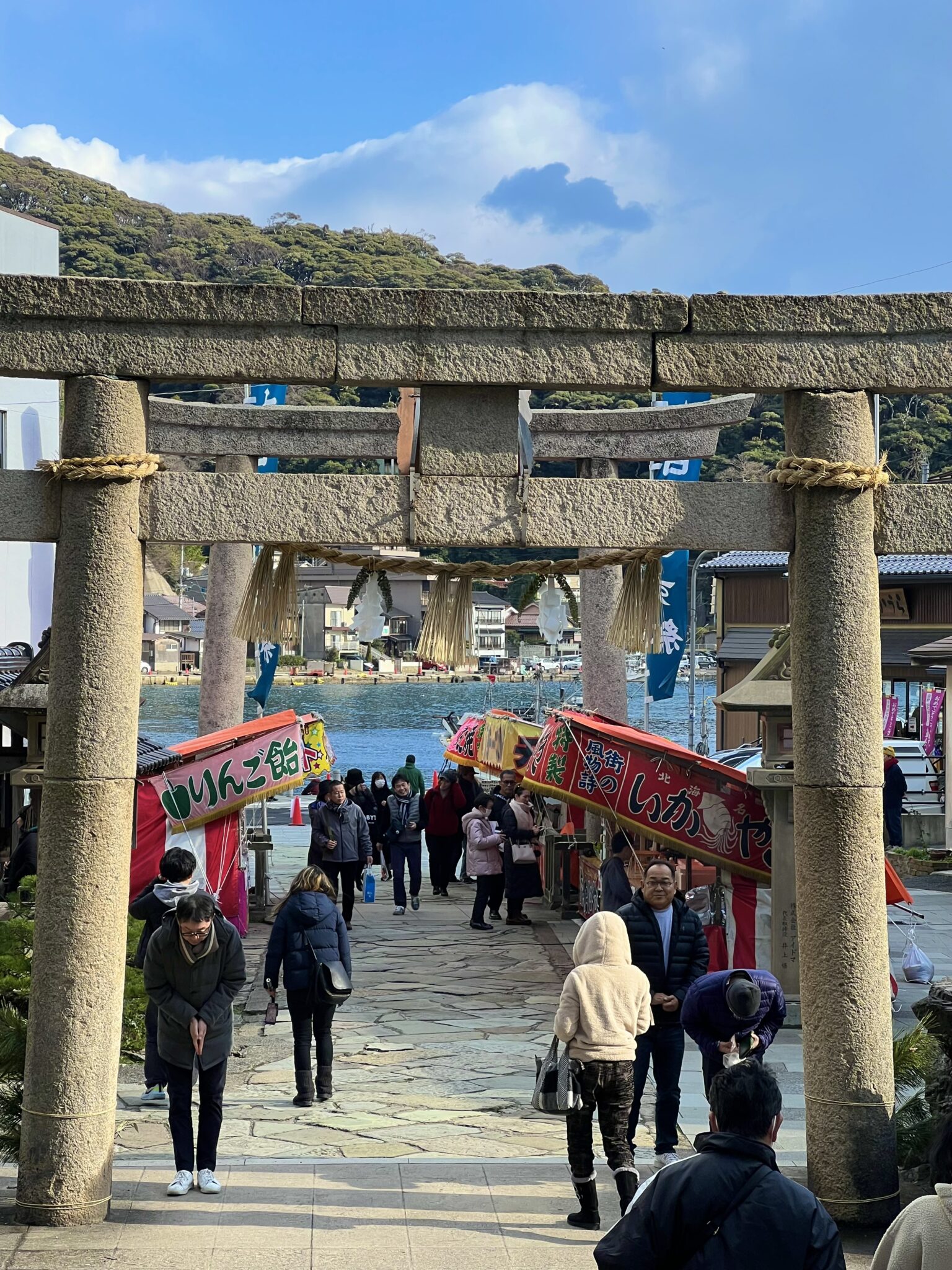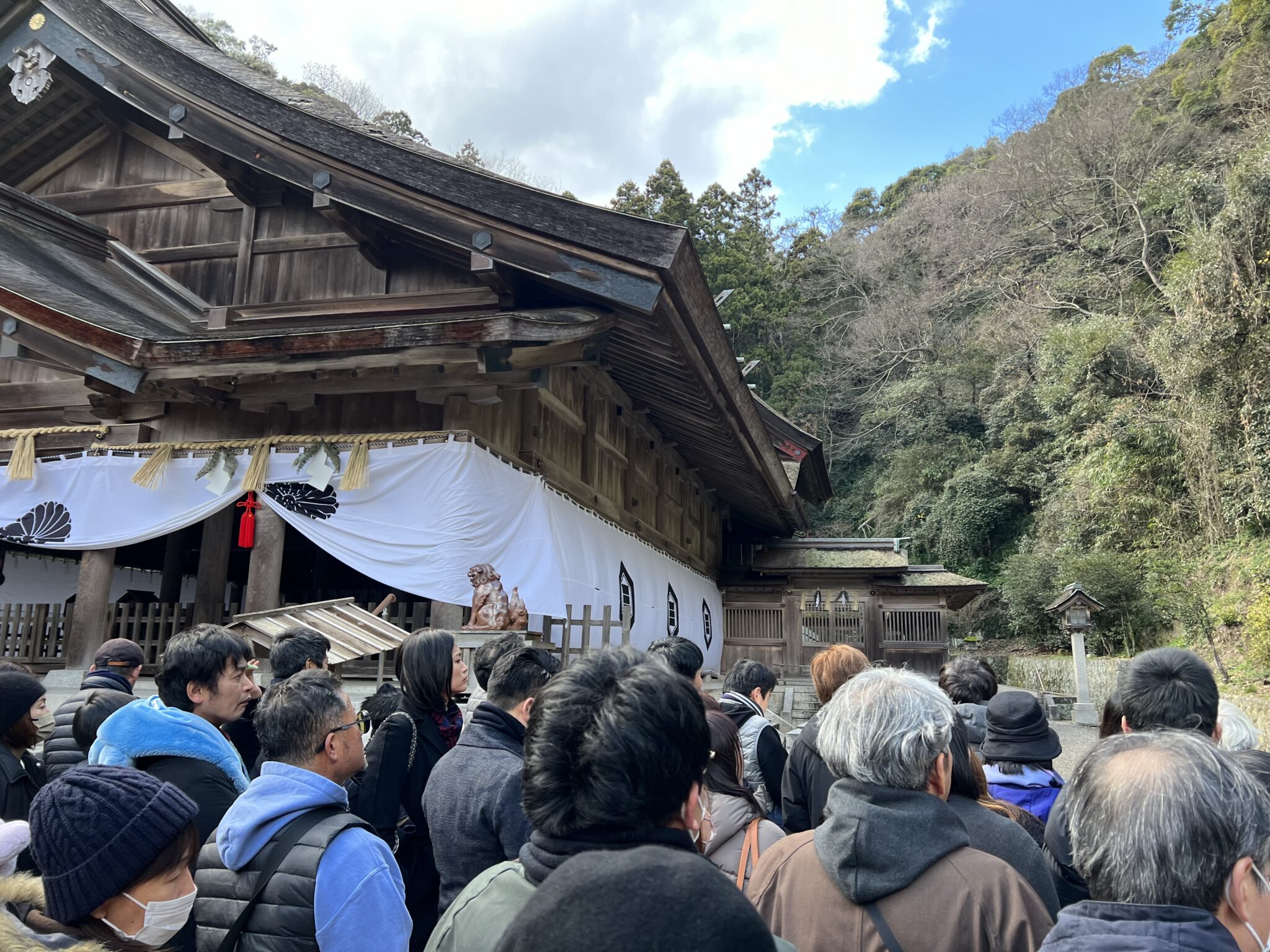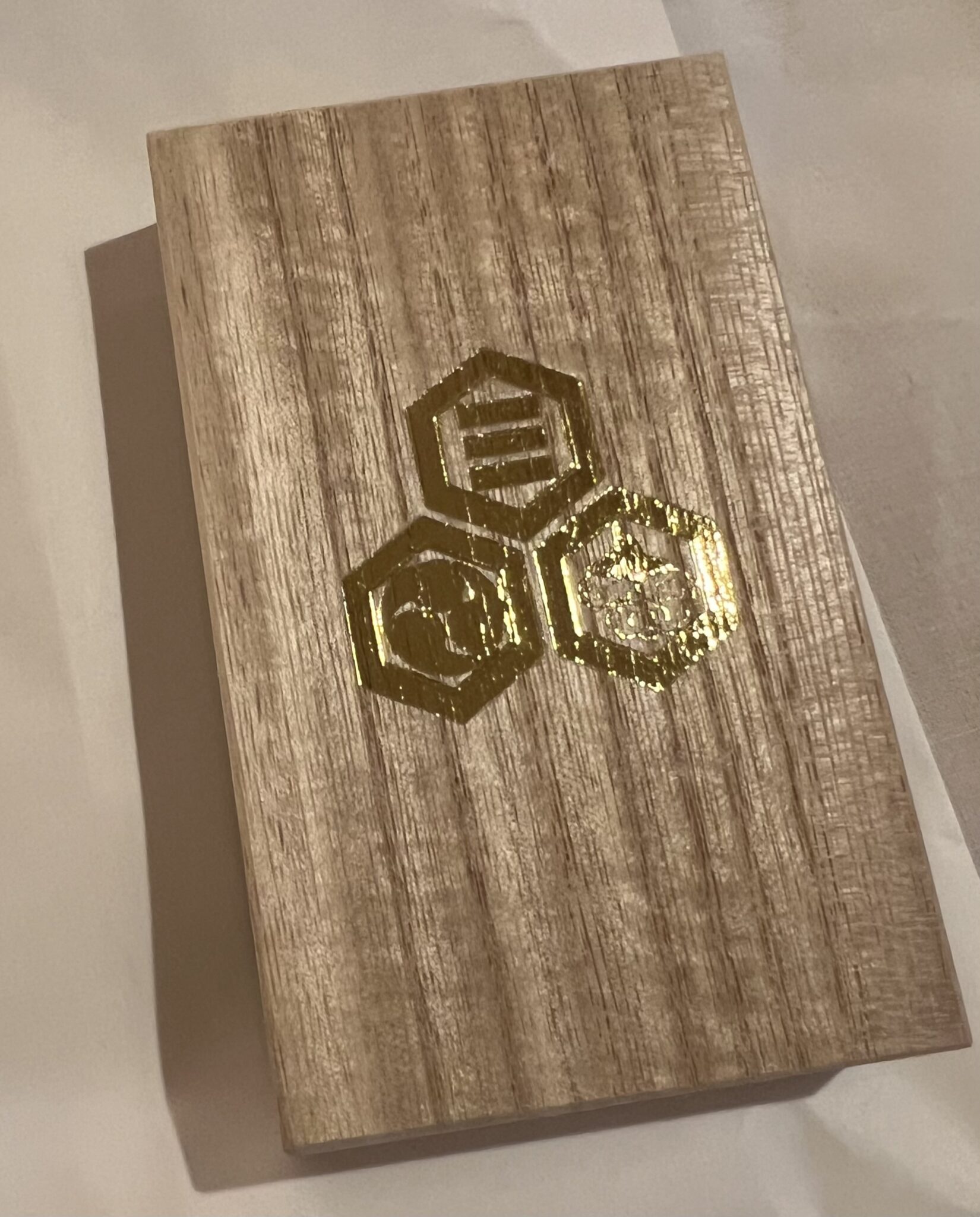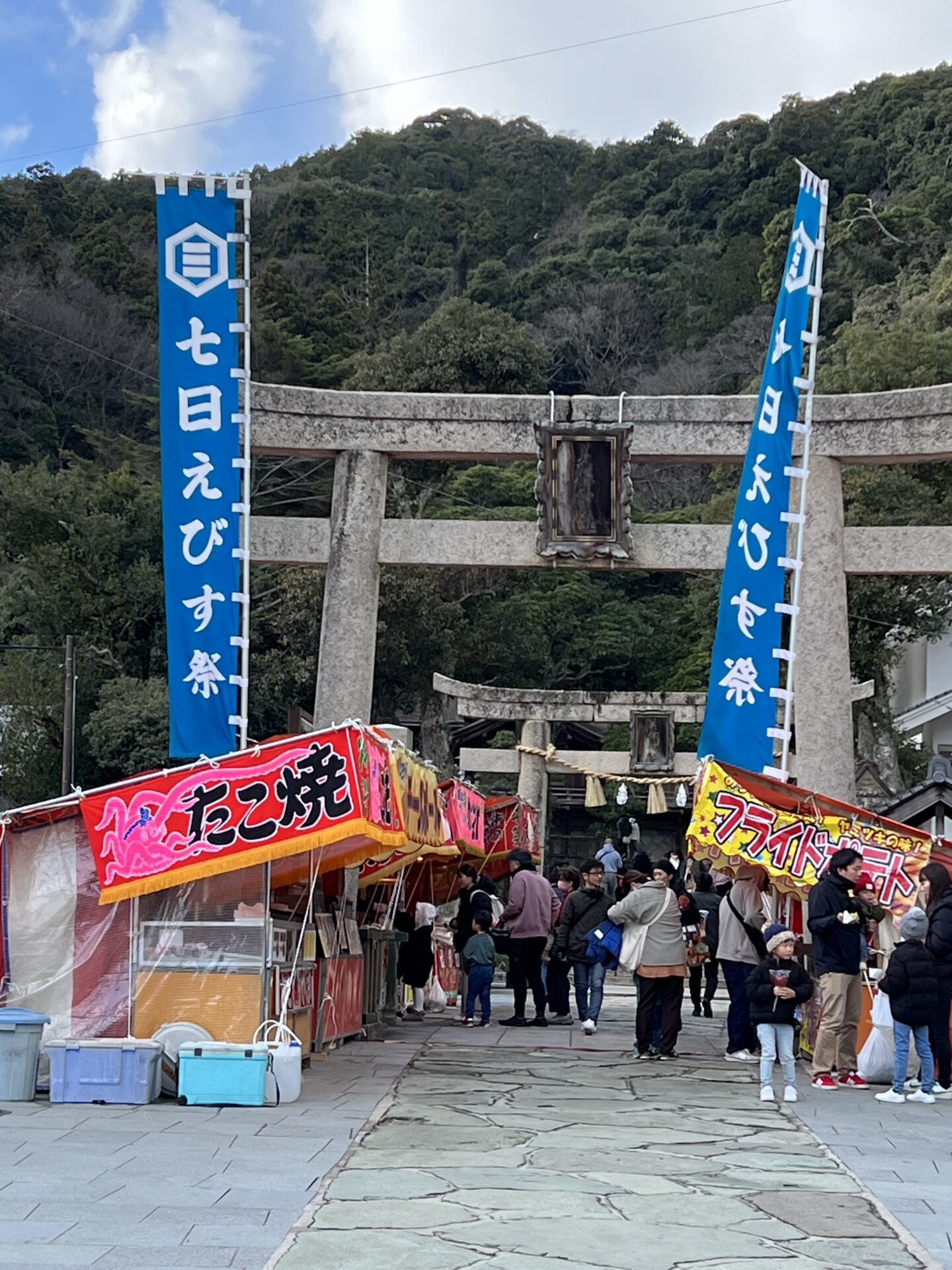I learned about this shrine, facing a small inlet near the tip of the Shimane Peninsula, after I started planning my visit to Izumo Taisha. It seems that visiting Izumo Taisha, Miho Shrine, and Hinomisaki Shrine is known as the “Izumo Three Shrine Pilgrimage.” The deities enshrined at Miho Shrine are Mihotsuhime no Mikoto and the well-known Koto-shiro-nushi no Kami, also known as Ebisu. According to the Kojiki and Nihon Shoki, Ebisu is the eldest son of Okuninushi no Mikoto, who is enshrined at Izumo Taisha, and Mihotsuhime no Mikoto is said to be Okuninushi’s wife (though it’s unclear if she is Ebisu’s biological mother).
For this reason, Izumo Taisha and Miho Shrine are said to enshrine a parent and child, and since both are gods of matchmaking, visiting both shrines is believed to double the blessings. Incidentally, the deities enshrined at Hinomisaki Shrine are Amaterasu and Susanoo. Since Susanoo is an ancestor of Okuninushi, there is a familial connection here as well. The Izumo Kuniyuzuri myth outlines how Okuninushi endured the trials given by Susanoo, became the ruler of Ashihara no Nakatsukuni (the central land of reed plains), successfully established the country, and then relinquished it to Amaterasu in exchange for being granted Izumo Taisha.
Knowing a bit about Japanese mythology can enhance your enjoyment when visiting the various shrines during a trip to Izumo, so I highly recommend it.

Access
It seems like you’ll need plenty of extra time to reach Miho Shrine if you’re not traveling by car. When touring the Izumo area, using a rental car is the most efficient option. For this trip, we flew into Izumo, rented a car to visit many shrines, and finished by staying at a hot spring in Maniwa, before returning via Yonago Airport. Miho Shrine is easy to find—just head toward the eastern tip of the Shimane Peninsula, and you’ll arrive as it’s practically a straight road.
If you’re visiting during a shoulder season, it shouldn’t be a problem, but on special occasions like the Ebisu Festival on the 7th of every month or New Year’s, the parking lots around the small port can become crowded with cars. In such cases, it may take time to find a parking spot, so it’s something to keep in mind.
Deities
— Mihotsuhime no Mikoto
Blessings for abundant harvests, marital harmony, safe childbirth, prosperity of descendants, and performing arts.
— Kotoshironushi no Kami (Ebisu)
Blessings for maritime safety, plentiful fishing, prosperity in business, academic success, and performing arts.
History
According to ancient documents, Miho Shrine is mentioned in the Izumo Fudoki compiled in 733, suggesting that the shrine existed at least by the early 8th century. The shrine’s website mentions that fragments of magatama (curved beads) from around the 4th century and clay horses used for rain rituals, believed to be from around the 6th century, have been unearthed from the grounds. This suggests that the site was a place for religious rituals even before the time of the Fudoki.
In terms of its natural surroundings, the shrine is located near the eastern tip of the Shimane Peninsula, facing a natural inlet, with the majestic Mount Daisen in Tottori towering across the sea. It is a place where one is naturally inclined to offer prayers.

Virtues/ Blessings
Blessings for: abundant harvests, marital harmony, safe childbirth, prosperity of descendants, maritime safety, plentiful fishing, business prosperity, academic success, and performing arts.
Blessings for performing arts: Miho Seki, as an important transportation hub and fishing port, was also a waiting spot for favorable winds for the Kitamaebune trading ships. There is an old saying among the sailors: “The god of Seki loves music,” and throughout history, many musical instruments have been offered to the shrine from across the country, wishing for maritime safety.
According to the shrine’s website, “In 1992, the ‘Dedication of Performing Arts,’ which had ceased in the early Meiji period, was revived after 100 years. During this unique music festival, top-tier performers play music facing the deity (with their backs to the audience), and the audience refrains from any applause.” This tradition aligns with the style of Noh performances, which were originally offerings to the gods and did not seek applause from the audience.
Shrine Ground
— Main Hall (Important Cultural Property)
In the right hall (from the viewer’s perspective), Mihotsuhime no Mikoto is enshrined, and in the left hall, Kotoshironushi no Kami is enshrined. These two halls are connected by a special structure called the “Shouzoku-no-Ma” (Robe Room), which creates a unique style of architecture known as Miho-zukuri or Hiyoku Taisha-zukuri.
— Worship Hall, Shrine Gate, and Corridors
Constructed in 1928, made of hinoki cypress wood.
— Power Spot
Behind the main hall, there is an adorable stone statue of a turtle in a side ditch. The spring water that flows out in front of this statue from the mountain behind has never dried up, which is considered very auspicious. When I visited, I saw a family with young children trying to balance coins on the turtle’s shell (which is surprisingly tricky), and it was heartwarming. The mountain rises directly in front of you, creating a quiet and serene atmosphere.

Offerings
Since Ebisu is enshrined here, there are many fun things related to Ebisu and sea bream (tai). The ema (votive plaques) at Miho Shrine feature an image of a sea bream, and the string is noticeably longer than usual, symbolizing a fishing line for catching the fish.
Miho Shrine is the head shrine of all Ebisu shrines across Japan, and on the 7th of every month, a celebration called “Nanoka Ebisu” takes place. On this day, visitors can enter a lottery for the chance to purchase a special charm adorned with a golden sea bream. The shrine grounds are packed with people eager to draw a ticket for the lottery. To our surprise, my husband managed to win the lottery and received the golden sea bream charm! What’s inside is a secret.

Additional Highlights
The view of Miho Port through the torii gate from the shrine approach is incredibly beautiful. On clear days, you can see the majestic Mount Daisen across the sea. Just outside the torii gate to the left is “Aotatami Yokocho,” a street of inns dating back to the Edo period, but it seems to have declined significantly since the pandemic. I’ve heard that it used to be quite lively. Though the street is very narrow, you might still get a sense of its old-time atmosphere.

